Unusual seasonal foods (by Simone Boyd)
Simone Boyd occasionally writes, or makes videos, about about unusual foods that you can grow. Simone is owner of the online veggie seed shop, Heirloom Naturally.
Strawberry spinach
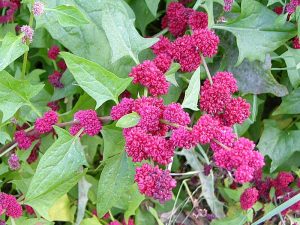 I grow strawberry spinach (Blitum capitatum syn. Chenopodium capitatum) mainly for the tiny, edible ‘strawberries’ which form towards the end of the plants season. Not a true strawberry, but they make a great addition to salads or as an edible flower alternative. The leaves are also edible as a spinach substitute (just pick them off as soon as they get to a size that you can harvest).
I grow strawberry spinach (Blitum capitatum syn. Chenopodium capitatum) mainly for the tiny, edible ‘strawberries’ which form towards the end of the plants season. Not a true strawberry, but they make a great addition to salads or as an edible flower alternative. The leaves are also edible as a spinach substitute (just pick them off as soon as they get to a size that you can harvest).
The plants are pretty easy to grow. I sow direct into well-prepared soil (addition of compost prior to planting) then just keep moist until germination. They tend to do better here in the cooler months, but are also worth a try during Summer. The plant will readily self seed so let it go if you want free plants, or make sure you eat the berries if not.
Kale-ini
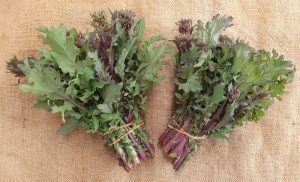 “What on earth is kale-ini?“, you may ask. Well, it is a word that I have made up to describes the crop that you are about to be introduced to.
“What on earth is kale-ini?“, you may ask. Well, it is a word that I have made up to describes the crop that you are about to be introduced to.
If you have grown kale throughout Winter, you will know that the change in temperature and sunlight signals it is time to create the next generation, and your kale will start developing flowering stalks.
But, before you pull it out to make way for your summer crops, wait! The florets produced by your kale plants are 100% edible and rather delicious, providing that you harvest them prior to the floret opening. Hence, why I call the crop kale-ini, as it is effectively a broccol-ini alternative.
Harvest the thicker stems and pop the thin, spindly ones in the compost as they are often fibrous. Aphids will love your kale-ini as much as you do, so inspect the florets for these little critters (a jet of water will dislodge them from the plant, or even a flick of the floret onto your palm once harvested will often do the trick).
As the weather warms up, you will need to harvest stems daily. Doing so will then see the plant reward you with more kale-ini stems. Steamed, stir fried or even roasted – it makes the hungry gap of Spring something to look forward to.
Kayla Blackmore
Up until August 2021, this column was written by Kayla Blackmore, who worked for Melbourne Farmers Markets and was the market manager of Coburg Farmers’ Market.
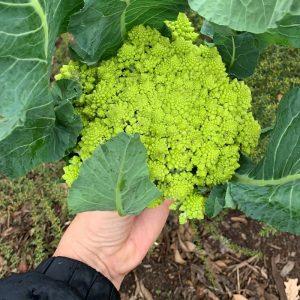 Romanesco (August)
Romanesco (August)
Gosh, nature is a fun little playground! Was there were ever a veggie that caught more attention at the market, or had the kids more eager to eat their greens, than the funky looking romanesco? Debate continues as to whether this brassica is closer to a broccoli or a cauliflower, but I like to think that it can hold its own in the veggie world! Romanesco is in season now in Victoria and pairs beautifully with other brassicas and root vegetables, along with lashings of olive oil, butter and cream. Try roasting it and sprinkling with dukkah, slice it and bake it with cream and cheese (à la au gratin) or use it as a fun ingredient in your next curry. You’ll be able to pick up romanesco at the farmers markets for the next few weeks. Be sure to get the kids to try it!
Celeriac (July)
A knobbly, rotund little guy, celeriac can look a bit intimidating to the uninitiated. But actually, it’s easy to prep this root vegetable. Just give it a little scrub, 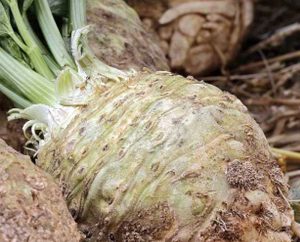 trim the top and bottom with a sharp knife, strip off the outer skin with a vegetable peeler, and trim any recessed parts of the root. Unpeeled and unwashed, it will last for up to three weeks in the fridge, or you can wash, chop and blanch celeriac before popping it in the freezer. The beauty of celeriac is in its versatility: roast it, sauté it, slice it gossamer thin and serve in a salad or alongside cabbage in a coleslaw. I’d argue that there are few ways of cooking it more divine than letting it soften in gently bubbling milk, adding a pinch of salt and a squeeze of lemon, and blitzing. The end result is a luxuriously creamy and rich puree that features just a hint of nuttiness and aniseed. Best of all, you can make it in advance and simply re-heat.
trim the top and bottom with a sharp knife, strip off the outer skin with a vegetable peeler, and trim any recessed parts of the root. Unpeeled and unwashed, it will last for up to three weeks in the fridge, or you can wash, chop and blanch celeriac before popping it in the freezer. The beauty of celeriac is in its versatility: roast it, sauté it, slice it gossamer thin and serve in a salad or alongside cabbage in a coleslaw. I’d argue that there are few ways of cooking it more divine than letting it soften in gently bubbling milk, adding a pinch of salt and a squeeze of lemon, and blitzing. The end result is a luxuriously creamy and rich puree that features just a hint of nuttiness and aniseed. Best of all, you can make it in advance and simply re-heat.
Celeriac pairs well with roasted meat of all types, pan-seared seafood, or even sautéed oyster mushrooms. You can buy it now at farmers’ markets.
Chestnuts (May)
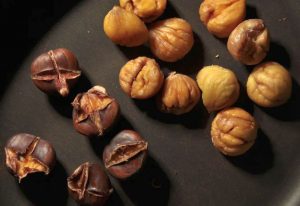 May is the month to get excited about the new season nuts, including walnuts and chestnuts. Is there anything more evocative than the aroma of chestnuts roasting over hot coals? If you don’t own an open fire or barbeque with coals, you can roast your chestnuts in the oven. Heat your oven to 200-220 degrees Celsius. Then score each chestnut shell with an ‘x’ on top and place them on top of a cooling rack that is sitting in an oven tray. Pop into the oven and roast for 15–20 minutes. Your home will be filled with a unique and toasty aroma! Place the warm chestnuts into a tea towel and use this to roll the nuts around inside to remove the skins. Serve warm if you can.
May is the month to get excited about the new season nuts, including walnuts and chestnuts. Is there anything more evocative than the aroma of chestnuts roasting over hot coals? If you don’t own an open fire or barbeque with coals, you can roast your chestnuts in the oven. Heat your oven to 200-220 degrees Celsius. Then score each chestnut shell with an ‘x’ on top and place them on top of a cooling rack that is sitting in an oven tray. Pop into the oven and roast for 15–20 minutes. Your home will be filled with a unique and toasty aroma! Place the warm chestnuts into a tea towel and use this to roll the nuts around inside to remove the skins. Serve warm if you can.
Pine mushrooms (April)
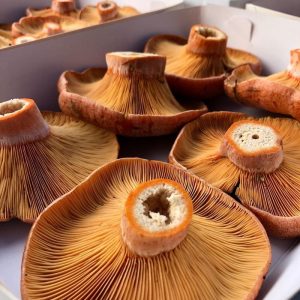 “All the mushrooms that we get and bring to market are wild mushrooms. They cannot be cultivated. That’s what makes them unique and that’s why they’re only at farmers’ markets for a short period of time.” (Vlad, owner of Melbourne Pine Mushrooms). According to Vlad, the best way to store them is on paper trays, which should then be put in paper bags and refrigerated. Tip: pine mushrooms will oxidise and turn a greenish colour when bruised or damaged so handle them with care; however, they are still perfectly fine to eat if they have turned green. They love salt, oil and butter (don’t we all?) and are amazing on toast for breakfast or in a hearty stew or pasta sauce.
“All the mushrooms that we get and bring to market are wild mushrooms. They cannot be cultivated. That’s what makes them unique and that’s why they’re only at farmers’ markets for a short period of time.” (Vlad, owner of Melbourne Pine Mushrooms). According to Vlad, the best way to store them is on paper trays, which should then be put in paper bags and refrigerated. Tip: pine mushrooms will oxidise and turn a greenish colour when bruised or damaged so handle them with care; however, they are still perfectly fine to eat if they have turned green. They love salt, oil and butter (don’t we all?) and are amazing on toast for breakfast or in a hearty stew or pasta sauce.
